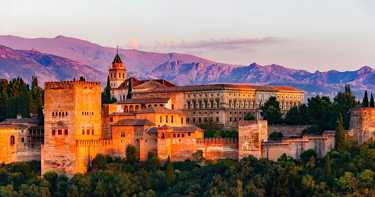Spain: What to see and do?
Spain is a must-see destination for sun, beach, culture and food lovers. Here are some of the main sights to see during your trip to Spain:
La Sagrada Familia in Barcelona: this impressive basilica is the work of architect Antoni Gaudí and has been under construction for over a century.
The Alhambra in Granada: this complex of Moorish palaces and gardens is a masterpiece of Islamic architecture and a symbol of Muslim Spain.
The Prado Museum in Madrid: This museum houses an impressive collection of European paintings, including works by Velázquez, Goya and Rubens.
Seville's Old Town: Seville's historic district is one of the largest in Europe and is famous for its Gothic cathedral and clock tower.
La Concha Beach in San Sebastian: This sandy beach is considered one of the most beautiful in Europe and is lined with tapas bars and restaurants.
There are many ways to get around Spain. High-speed trains are the fastest and most comfortable way to travel between major cities, with lines such as the famous AVE connecting Madrid to Barcelona. Buses are also an economical way to get around, with companies like Alsa and Avanza offering regular routes between cities and regions. For travel within cities, the metro is often the most convenient mode of transportation, with well-developed networks in major cities such as Madrid and Barcelona. It is also possible to rent a car to explore the more rural areas of Spain, although driving in the big cities can be stressful and complicated.
Finally, food is an essential part of Spanish culture and travelers should not miss out on local specialties such as paella, tapas and fresh seafood. Spanish wines are also world-renowned, especially the red wines of Rioja and the sparkling cavas of Catalonia.
Spain: How to get around the country?
Are you a tourist in Spain and curious to discover the wonders of the country's different cities? Wondering how to get from one city to another? Don't worry, we've got all the information you need to ensure an easy and enjoyable trip.
Spain has an excellent transport network, making it easy to get between cities. Here are the main modes of transport you can consider:
Domestic flights: If you want to save time, domestic flights are your best choice. The main airlines in Spain are Iberia, Vueling and Ryanair. These airlines offer regular flights between the country's main cities, such as Barcelona, Madrid, Seville and Valencia. Be sure to check online offers and fares in advance to get the best prices.
Trains: Spain has one of the best rail networks in Europe, operated by Renfe. Trains are comfortable, fast and reliable. You can choose between high-speed trains (AVE), regional trains (MD and Avant) and night trains (Trenhotel). Major rail links include Barcelona-Madrid, Madrid-Seville and Madrid-Valencia. It is advisable to book your tickets in advance, especially during peak periods and weekends.
Buses: If you're looking for an economical option, buses are an excellent alternative. The main bus companies in Spain are ALSA and Avanza. They offer frequent routes between the main cities and rural areas. Buses are often comfortable, with air conditioning and on-board toilets. Tickets can be purchased online, at bus stations or directly from the driver.
Car: If you prefer to explore the country at your own pace, renting a car can be an excellent option. Spain's roads are generally well maintained, and there's an extensive motorway network. The main car rental companies in Spain are Europcar, Avis, Hertz and Sixt. Be sure to check the driving and parking regulations in each city before you leave.
Now that you know the different modes of transport in Spain, here are a few more tips to make your trip easier:
- Plan your itinerary in advance and book tickets online whenever possible.
- Be flexible, as there may be unexpected delays or cancellations.
- Arrive early at airports, train and bus stations to avoid last-minute stress.
- Don't hesitate to ask locals or travel agents for help if you have any questions or concerns.
- Make sure you have a local SIM card or Internet access to stay connected and follow travel updates.
By following these tips and choosing the mode of transport that best suits your needs, you'll be ready to explore the many facets of Spain from city to city.
Spain: When to visit?
Spain is a southern European country renowned for its sunny Mediterranean climate and pleasant year-round temperatures. However, it's important to choose the best season to travel to Spain according to your preferences and planned activities.
Spring (March to May) and autumn (September to November) are generally considered the best seasons to visit Spain. Temperatures are mild, averaging between 15 and 25 degrees Celsius, perfect for exploring historic cities such as Madrid, Barcelona, Granada or Seville. Gardens and national parks are in full bloom, offering picturesque landscapes for walks and hikes.
Summer (June to August) is the peak tourist season in Spain, especially on the Mediterranean coast. Temperatures can reach 30 degrees Celsius or more, ideal for beach lovers. However, tourist numbers are often high and prices can be higher. It's advisable to book your accommodation and tickets in advance during this period.
Winter (December to February) is the low season in Spain. Temperatures can vary from 5 to 15 degrees Celsius, depending on the region. Ski resorts in the Pyrenees and Sierra Nevada are popular with winter sports enthusiasts. Cities like Madrid and Barcelona also offer a festive atmosphere with Christmas markets and traditional Christmas celebrations.
The best season to travel in Spain depends on your preferences and planned activities. If you prefer milder temperatures and avoid the crowds, spring and autumn are the best choices. If you like warmth and lively beaches, then summer is for you. Finally, winter is ideal for winter sports and Christmas festivities.

